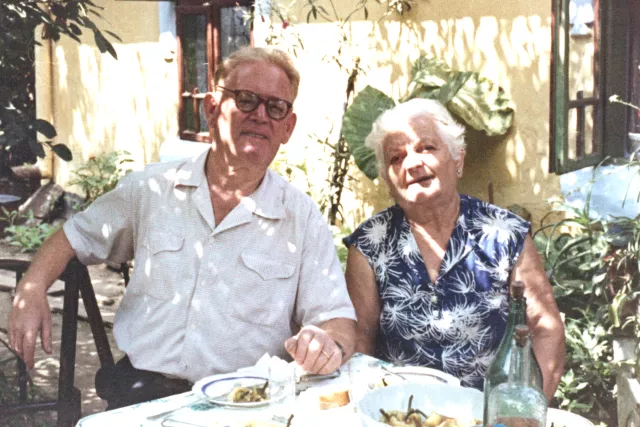Surica and Friederich Leinweber
This photo features my parents, Friederich Leinweber and Surica Marcus Leinweber in the courtyard of their house in Bucharest, in the Aparatorii Patriei quarter, in 1975.
My mother, Surica Marcus Leinweber [nee Froim], came to Bucharest with her sister, Liza. She learnt to make brushes and paintbrushes, and she exercised this trade. She owned a workshop built by my biological father, but she couldn't keep it, so she sold it with workers included and ended up working herself in her former workshop.
My biological father, Carol Marcus, died in April 1921, when I was 8 months old, and my mother remarried in 1924. She died in 1985.
My stepfather, Friederich Leinweber, was a worthy man. His behavior was beyond reproach and I never felt he was my stepfather. I remember my mother introducing him to me: 'Look, daddy's here, daddy's here!' I was two years and a half. He never did raise his voice at me, curse me, pull my ears or slap me. On the contrary, whenever I beat up my brothers - his children -, he left the house and looked for something to do elsewhere, lest he should lose control and say something bad or hit me. So I can say he loved me. He died in 1982.
From the age of 8 until I got married, I lived in the Aparatorii Patriei [quarter]. The house had its charm because, when we moved, it was being built. So I witnessed how a house was built. The roof was hastily made, because we had no authorization for the house. If the gendarmes caught you building a house without authorization, they would stop you, unless the house already had a rood. So the pillars were fixed in a hurry, the roof was completed fast, and so were the timber walls. Reeds were added to the walls, and then came the plaster and the whitewash. Most houses were built directly on the ground. There were many Jewish families in the Aparatorii Patriei quarter - over 60 families. The neighborhood was founded in 1927, at the outskirts of the capital, on a ground divided into lots. There was no pavement, no electricity, no sewerage, and no drinking water. There was a well here and there, from which water was extracted from a depth of 25 meters. There was a synagogue in our neighborhood - it didn't have a specific name, it was the synagogue in Aparatorii Patriei. There could be no service held in the morning in our neighborhood, because most of the men went to work and the remaining ones weren't enough to complete a minyan. There was no service in the evening either, but holidays were treated with all the respect due to the historical moments they celebrated: Yom Kippur, Sukkot etc. It was a pleasure to see the sukkah built by the Jews of our neighborhood, one more beautiful and more elegant than the other. On Purim, it was a real joy when the masked characters came to your house, had a drink, ate your cakes, and thumbed their noses at you because you hadn't recognized who they were. We, the children, had a great time in those days. This lasted until the quarter was demolished. The Jews left to pursue the aliyah, and there were none left in the neighborhood.
The old Aparatorii Patriei quarter disappeared in the 1980's. A sea of apartment houses lies today in the area that was used for farming. The place where our house used to be is now surrounded by new buildings and streets. I, who spent my childhood in the middle of nature, inhaled fresh air and saw the starry sky, confess I still miss it. None of the buildings I knew survived. Everything was demolished during Ceausescu's regime and new buildings were erected to accommodate more people who came from outside than people from the neighborhood. The terrain was cleared by the demolition of the modest houses, which had small courtyards and orchards. And so, the people of the old neighborhood scattered around and they lost track of one another.





























